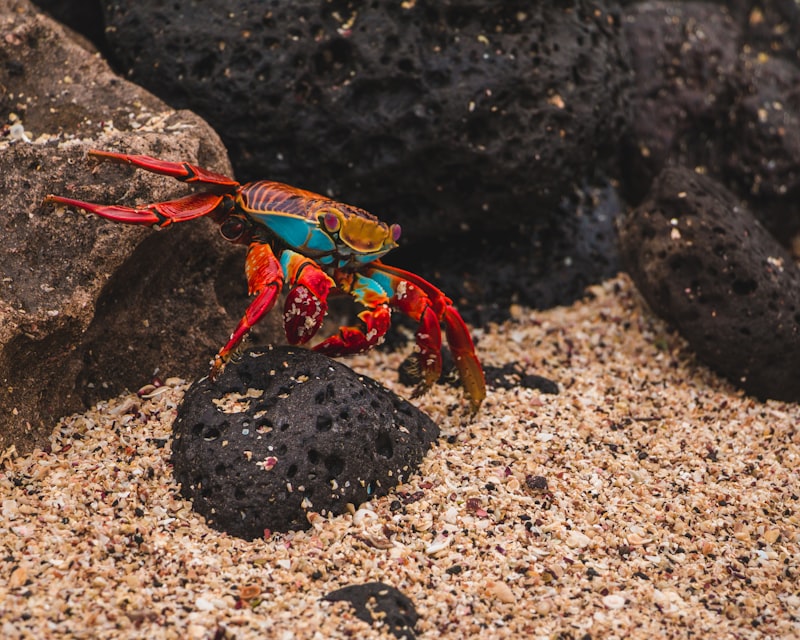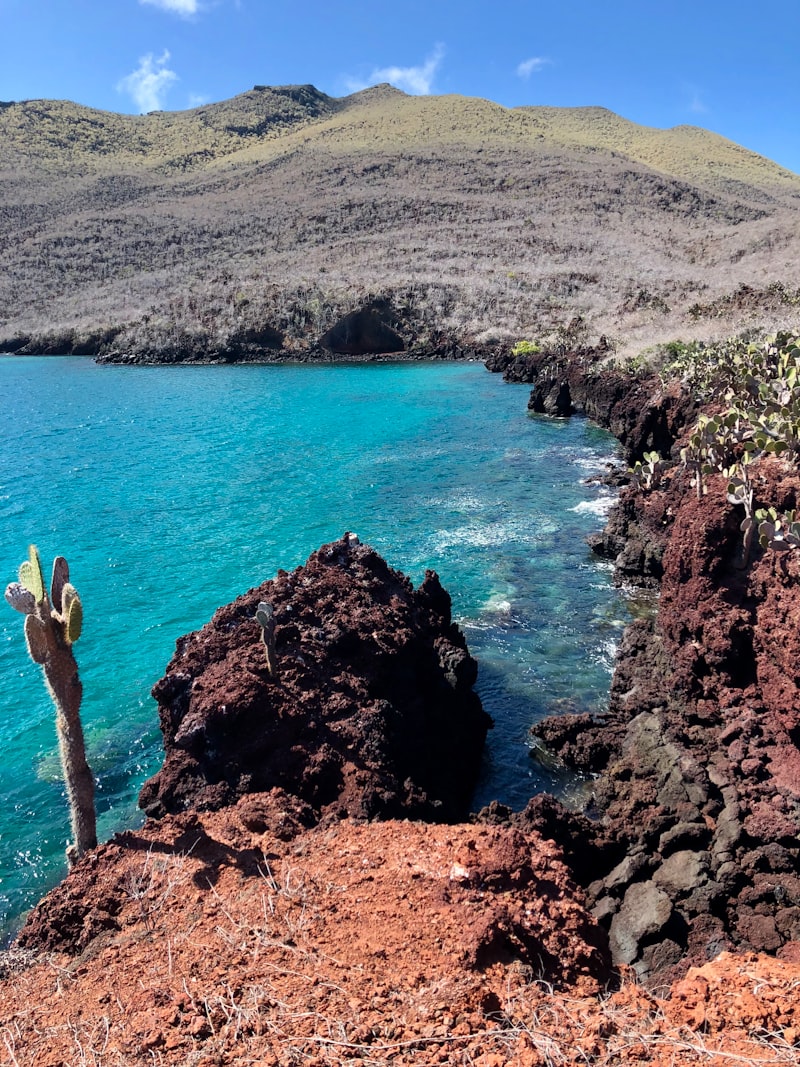Imagine encountering the marine iguanas, the world’s only sea-going lizards, elegantly swimming through crystal-clear waters. These bizarre creatures, adapted to diving for algae, showcase nature’s incredible ability to adapt to its environment. Their dark, rugged appearance contrasts sharply with the serene ocean backdrop, making them a sight to behold.
In the skies above, the waved albatrosses perform their intricate mating dances, a spectacle that echoes the island’s untouched beauty. These majestic birds, with their impressive wingspan and graceful flight, symbolize freedom and endurance in the vast Pacific.
Venture inland, and you might encounter the Galapagos penguins, the only penguins to live north of the equator. These diminutive birds navigate the warm equatorial waters with surprising ease, showcasing evolution’s ingenuity in adapting to diverse climates.
Among the island’s most enigmatic residents are the Sally Lightfoot crabs, their vivid red, orange, and blue shells dotting the volcanic rocks like living gemstones. These agile scavengers add a splash of color to the stark landscapes, embodying resilience and adaptation in a harsh environment.
Each creature in the Galapagos Islands tells a story of survival against the odds, shaped by millennia of isolation and unique environmental pressures. From the elusive Darwin’s finches, with their diverse beak shapes reflecting specialized diets, to the playful sea lions that frolic in shallow waters, every species contributes to the islands’ rich ecological tapestry.
Exploring the Galapagos is a journey through time and nature’s boundless creativity, where every encounter with these weird and wonderful creatures offers a glimpse into the marvels of evolution.
Galapagos Wonders: Unveiling the Strange Creatures That Defy Evolution
Imagine walking on beaches where marine iguanas, the only lizards in the world that swim in the ocean, bask in the sun. Their dark coloration helps them absorb heat after diving deep to feed on algae, a sight that defies conventional lizard behavior. Meanwhile, giant tortoises, some weighing over 500 pounds, lumber through dense forests with a grace that belies their size, each one a living relic of prehistoric times.
The Galapagos penguin, the only penguin species to live north of the equator, thrives in these warm waters, showcasing evolution’s adaptability in the face of geographic challenges. These pint-sized birds dart through the waves with remarkable agility, a stark contrast to their Antarctic cousins.
Birdwatchers revel in the diverse avian life, from the blue-footed booby’s comical courtship dance to the waved albatross’ majestic flights. Each species plays a crucial role in the island’s ecosystem, contributing to the delicate balance that Darwin himself found so intriguing.
As you explore these wonders, you can’t help but marvel at nature’s ingenuity. How did these creatures evolve in such isolation, developing traits that are both bizarre and brilliant? The Galapagos Islands stand as a living laboratory of evolution, where every creature, big or small, tells a tale of survival against the odds.
Mysteries of Evolution: The Bizarre Beings of Galapagos Explored
Have you ever wondered about the incredible journey of evolution? Look no further than the Galapagos Islands, where nature’s creativity has produced some of the most bizarre beings on Earth. Imagine walking among giant tortoises that seem like relics from prehistoric times, or encountering marine iguanas that elegantly swim through the crystal-clear waters. These islands, scattered in the Pacific Ocean, hold secrets that challenge our understanding of life itself.
One of the stars of this evolutionary drama is the Galapagos tortoise, a species that can live for over a century and grow to immense sizes. These gentle giants amaze scientists with their longevity and adaptability, traits honed over millennia in isolation on these volcanic islands. Each tortoise carries a unique story etched in its weathered shell, a testament to survival against all odds.
But it’s not just on land where evolution thrives in Galapagos. Beneath the waves, the marine iguanas defy traditional reptilian norms by foraging underwater for algae. These specialized swimmers have adapted to their oceanic environment, their distinctive appearance reflecting their unique lifestyle. It’s as if nature decided to blend the traits of lizards and fish, creating a creature perfectly suited to its coastal habitat.
The Galapagos Islands continue to astonish researchers with their biodiversity. From the flamboyant courtship dances of blue-footed boobies to the elusive flightless cormorants, each species plays a crucial role in the delicate balance of this ecosystem. These evolutionary wonders not only captivate biologists but also remind us of the boundless creativity of life on Earth.
Visiting the Galapagos is like stepping into a living laboratory where evolution unfolds before your eyes. Every creature, big or small, tells a story of adaptation and survival in a constantly changing world. It’s a place where the weird and wonderful coexist, offering a glimpse into the mysteries of our planet’s past and the possibilities of its future.
So, next time you marvel at nature’s diversity, remember the Galapagos Islands and the bizarre beings that call it home. They are not just survivors; they are storytellers of evolution, teaching us about resilience, innovation, and the endless surprises of life on Earth.
From Blue-footed to Albatross: A Journey Through Galapagos’ Unique Wildlife
Imagine setting foot on these volcanic islands and encountering the iconic blue-footed boobies, known for their vibrant azure feet that capture the attention of all who behold them. These seabirds are not only a sight to behold but also play a crucial role in the Galapagos ecosystem, with their fishing prowess and intricate mating dances.
Moving through the archipelago, one might come across the magnificent albatrosses, with their impressive wingspans and graceful flight. These seabirds travel vast distances across the ocean but return to the Galapagos to breed, making it a vital sanctuary for their survival.
The Galapagos Islands are also home to giant tortoises, whose slow and steady demeanor belies their resilience and importance in conservation efforts. These gentle giants have adapted to various habitats across the islands, showcasing evolution at its most intriguing.
In addition to these well-known inhabitants, the Galapagos teems with marine life, from playful sea lions to colorful marine iguanas that forage in the intertidal zones. Each species has evolved in isolation, leading to unique adaptations that highlight the islands’ biological significance.
Exploring the Galapagos’ wildlife is not just a journey through nature but a profound experience of discovery. It offers insights into evolutionary processes, conservation challenges, and the delicate balance of ecosystems that are crucial for the planet’s biodiversity.
Beyond Darwin: How Galapagos Islands Continue to Amaze Scientists
Scientists are continually astounded by the islands’ ability to provide a living laboratory for evolutionary studies. The Galapagos’ isolation has allowed species to evolve in relative isolation, leading to the development of unique traits and behaviors. This natural wonderland challenges conventional understanding of how species adapt and thrive, providing valuable insights into evolutionary biology.
Beyond its fauna, the Galapagos Islands also harbor diverse ecosystems that are delicately balanced and highly specialized. Each island presents a microcosm of evolution, where species interactions and environmental factors shape their survival strategies. This intricate web of life offers scientists unparalleled opportunities to study ecological dynamics and the impacts of human activity on fragile ecosystems.

Moreover, the ongoing research and conservation efforts in the Galapagos Islands underscore their critical importance in understanding global biodiversity and climate change. Scientists and conservationists work tirelessly to preserve these fragile ecosystems and the species that call them home, recognizing their significance in the broader context of environmental stewardship.

The Galapagos Islands remain a beacon of scientific curiosity and conservation efforts, continuing to inspire awe and discovery among researchers worldwide. As our understanding deepens, so does our commitment to safeguarding these extraordinary islands for future generations to explore and cherish.
Frequently Asked Questions
How can visitors to the Galapagos Islands help protect its unique wildlife?
Learn how visitors to the Galapagos Islands can contribute to protecting its unique wildlife through responsible tourism practices. Discover actionable tips on minimizing ecological impact, respecting wildlife habitats, and supporting local conservation efforts.
How did the Galapagos Islands influence Charles Darwin’s theory of evolution?
Discover how the Galapagos Islands shaped Charles Darwin’s theory of evolution, showcasing unique species variations that sparked his insights into natural selection.
Why are the Galapagos Islands a hotspot for biodiversity?
Discover why the Galapagos Islands are renowned for their biodiversity. Learn about the unique geological history and isolated location that have allowed diverse species to evolve independently. Understand how conservation efforts and strict regulations help preserve this extraordinary ecosystem.
Which are some of the most iconic species native to the Galapagos?
Discover iconic species native to the Galapagos Islands, including the Galapagos giant tortoise, marine iguana, blue-footed booby, and Galapagos penguin.
What unique creatures can be found in the Galapagos Islands?
Discover unique creatures in the Galapagos Islands, including giant tortoises, marine iguanas, and blue-footed boobies. Each species has evolved uniquely due to the islands’ isolated environment, making them a must-see for nature enthusiasts.


